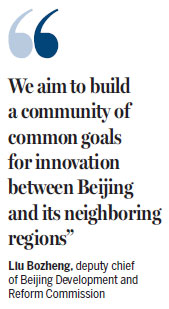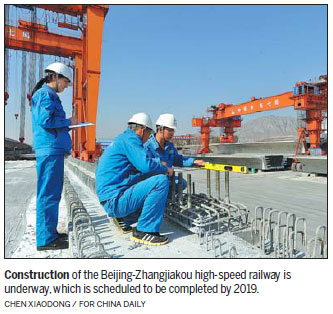Transfer of non-core industries to other areas well underway
The transfer over of Beijing's non-capital functions to other regions is a key part of a grand strategy to promote the integrated development of the city and neighboring Tianjin municipality and Hebei province, senior local officials said.
The aims of the process include adjusting the city's growth, improving living conditions - as well as solving the persistent problem of a growing population and limited resources, and highlighting Beijing's role as a national capital - said Cai Qi, Party chief of Beijing.
The program requires better coordination between Beijing and the regions receiving the transferred functions, according to the Party chief.
Through the removal of the less prioritized functions, Beijing will act increasingly as the core for regional development. The goal is for it to operate better as a center for politics, culture, international communications and innovation.

The operations to be transferred elsewhere - among them manufacturing, logistics, and wholesale markets - are gradually being phased out to ease Beijing's so-called "urban diseases," according to the municipal government.
Liu Bozheng, deputy chief of the Beijing Development and Reform Commission, said Beijing has made great progress in coordinating neighboring regions since the central government released a plan for the integrated development of the Beijing-Tianjin-Hebei region in 2015.
According to Liu, the regional collaboration has covered a range of areas including transportation, environmental protection, industrial development, innovation and public services.
Beijing, as the core of the regional integration, is now playing a leading role in driving development of its neighboring areas.
According to Liu, the cooperation in transportation has made great progress, as more high-speed railways and high-grade highways have been built or go under construction to better link Beijing and its neighboring areas.
He added that Beijing has extended 39 of its urban bus routes to neighboring cities. Residents can use the unified commuting pass for intercity travels by means of buses, trains and subways.
Beijing has also enhanced its coordination with Tianjin and Hebei in environmental protection through phasing out polluting industries, leading to steady improvements in air quality in the past two years.
In 2016, the average concentration of PM 2.5 - particulate matters with diameters less than 2.5 micrometers - decreased 23.7 percent from 2012. In the first nine months of the current year the average concentration was 60 micrograms per cubic meters, well within healthy levels of between 50 and 100 according to national standards.
Beijing also joined Zhangjiakou's efforts in ecological regeneration by planting about 80,000 hectares of trees.
Zhangjiakou, the Hebei city northwest of Beijing, is one of the sources of sandstorms affecting the capital. The afforestation efforts aim to benefit both cities as they are the hosts of the 2022 Winter Olympic Games.
The removal of Beijing's non-capital functions is by no means a transfer of the capital city's outdated production capacity to neighboring regions, Liu said.
"We aim to build a community of common goals for innovation between Beijing and its neighboring regions," he explained.
He said Beijing is cooperating with Hebei and Tianjin in building innovation parks and incubators to boost the share of Beijing's advanced research resources.
The nation's leading innovation base, Zhongguancun Science Park, has launched new industrial parks in Tianjin's Binhai New Area, as well as in the cities of Qinhuangdao, Baoding and Tangshan in Hebei province.
High-tech companies from Zhongguancun have set up nearly 3,000 subsidiaries in Tianjin and more than 3,000 in Hebei.
Beijing's businesses have also brought capital and technologies in other fields of advanced manufacturing into neighboring areas.
New investments include two data centers in Hebei's Zhangbei county, the new airport economic zone between Beijing's Daxing district and Langfang city in Hebei, and a Beijing Hyundai automaking plant in Cangzhou, Hebei province.
Liu cited statistics saying that investments from Beijing in Hebei and Tianjin totaled 203.9 billion yuan ($31.5 billion) in 2016, a 335 percent growth from 2014.
The integration also aims to build an alliance of players in public services, Liu noted.
He said Beijing has transferred a number of education and healthcare facilities to Hebei and Tianjin, allowing local residents to share Beijing's high-quality public service resources on their doorsteps.
"The plan for the integrated development for the Beijing-Tianjin-Hebei region calls for forming a world-class city cluster," Liu said.
He added that the central districts of Beijing, Beijing's sub-center in Tongzhou district and the Xiongan New Area in Hebei would be the major parts of the city cluster.
zhaoshijun@chinadaily.com.cn

(China Daily 11/30/2017 page7)














